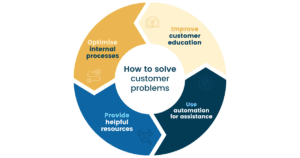
Did you know that 90 percent of customers regard issue resolution as the most important customer service factor?
This isn’t surprising. Customers primarily use products and services to solve their problems, fulfill needs, and get desirable outcomes. It’s your job to understand and resolve their pain points to offer a memorable customer experience and become their go-to brand.
In this article, we’ll show you how to find customer pain points and why it’s crucial for your small business. Plus, we’ll share common customer service problem-solving examples and discuss proven customer problem-solving strategies.
What are customer pain points?
Customer pain points are specific problems customers experience during their journey with your small business. Understating, finding, and fixing customer pain points allows customers to fully benefit from your product and helps you provide a memorable service experience.
Let’s discuss the four main types of customer pain points to help you better understand the concept:
- Process pain points: Problems and inconveniences customers experience because of a company’s customer-related processes.
- Financial pain points: Related to the amount customers pay for your services, the available payment methods, and the value they receive
- Support pain points: Problems customers experience while approaching and engaging with your support teams
- Productivity pain points: Issues customers experience when using your product features or services and the time it takes to solve their problems
Common customer pain point examples
Pain points occur at all stages of the customer journey, but some are more common than others. Let’s look at a few, from slow service to poor communication.
Slow customer support
Long wait times and unavailable service agents are among the biggest pain points that negatively impact customer experience. According to research, 67 percent of customers end a support call in frustration when they can’t reach a service representative. Fixing this problem can drastically improve customer satisfaction, too, since 93 percent of customers say they’re likely to keep doing business with a company that offers excellent customer service.
Lack of technical support
Customer service agents with limited technical knowledge are a major cause of frustration for customers. According to research, 31 percent of consumers consider technically sound and knowledgeable service agents critical to a service experience.
Inconsistent service experience
Small businesses with immature service processes and untrained service agents usually offer inconsistent service experiences to their customers. Unfortunately, this is quite common in the service industry.

Poor customer engagement and communication
Keeping customers engaged through regular communication at every stage of the customer lifecycle is critical for a memorable service experience. From onboarding and initial product tours to proactive customer education and issue resolution, your communication quality and frequency often determine if a customer renews their contract with you.
Complicated buying process
Long and complicated buying processes are a major customer pain point that prevents ready-buyers from purchasing your product. According to research by Gartner, 77 percent of customers believe their recent B2B purchase experiences have been very complicated. Shortening and simplifying this process can drastically improve your conversion rates.
The importance of customer service problem solving
The ability to empathise with your customers, calmly listen to their issues, and help them solve their problems is critical to your small business‘s brand image, retention rates, and overall customer satisfaction.
Research shows that a dissatisfied customer tells anywhere between nine and fifteen people about their bad experience with a brand. Why does this matter? Because 83 percent of consumers ask friends or personal connections before making a purchase decision.
Inefficiencies and issues leading to even one unsolved customer problem can potentially result in multiple lost leads and customers.
How to find your customers’ problems
Before you can solve customer issues, you have to discover them. There are a few ways to do this.
Ask customers about their experience
The best way to understand customer needs and identify and address pain points is by asking customers open-ended questions about their experience with your business in real-time or immediately after each engagement. You can do that by:
- Using CSAT surveys where customers can rate an experience on a five-star scale
- Running monthly or quarterly feedback surveys
- Using follow-up calls for customer feedback
- Taking proactive surveys and calls to get feedback on improving customer experience.
When seeking feedback through calls, allow customers to speak uninterrupted so that they express their true feelings about an experience or your product/service.
Make it easy to contact you
If you want customers to report problems and help you identify customer pain points, make contacting you as easy as possible. Here are a few ways you can do that:
- Display your support number in your website header.
- Offer live chat support.
- Add feedback prompts at every stage of the customer journey, including the checkout process.
- Offer multiple customer support channels.
Besides gathering feedback, be sure to record and organise it properly to extract actionable insights. This is where a customer relationship management (CRM) system comes in handy. A good CRM helps you record customer feedback from various touchpoints and get a customer support timeline to understand what triggered dissatisfaction and how it was handled.

See user engagement patterns
Some customers won’t respond to your surveys or calls—they may not even complain about their experiences. But you can still find out if they’re dissatisfied with your product through their engagement patterns.
Again, a CRM can play a critical role in this. An integrated CRM lets you see how regularly a customer uses your product. If they’ve gradually stopped, reach out to discover why.
Closely watch your online reviews
You can learn much about your product and service quality by reading your brand’s online reviews. Closely watch what your customers say and look for patterns to see if any specific problem comes up repeatedly. You can also study your competitors’ reviews to proactively identify problems your customers might face in the future.
How to solve customer problems

Once you identify customer problems, it’s time to solve them. This usually means updating your processes and content, educating customers, and using technology effectively.
Optimise internal processes
Based on customer feedback and insights, improve your internal processes and optimise them from your customer’s perspective. Your goal should be to enhance your customer experience and solve their problems without unnecessarily consuming their time.
Provide helpful resources
Creating a comprehensive customer help center with a knowledge base, FAQs, a well-trained customer service team, and in-depth, step-by-step product tutorials is an excellent way to minimize customer pain points and increase satisfaction. To do that, you’ll need to record the most frequent customer complaints about your product or processes and turn them into actionable self-help content that instantly resolves customer problems.
Use AI and automation for assistance
AI chatbots have revolutionised SaaS sales and customer service. Studies show that 68 percent of customers enjoy the quick response speed of chatbots. With the rise of ChatGPT and other advanced AI technologies, you can easily engage potential customers and reduce customer pain points and customer churn by automating conversations, speeding up responses, and minimising human error.
Improve customer education
Apart from process optimisation, you must also focus on customer education for problem-solving. With better product awareness, new customers will use your product more efficiently and resolve problems themselves, reducing the number of complaints and service tickets.
You can automate customer education by creating email sequences covering various product features, maintaining a blog sharing valuable tips, and growing a YouTube channel with helpful content.
Fix Customer Pain Points With Act!
With an integrated CRM and marketing automation system like Act!, you can gather and organise customer feedback, automate engagement, and identify unengaged or dissatisfied customers before it’s too late. If you want to provide a seamless customer experience and get priceless user insights to continually improve your customer interaction processes, try Act! for free today.






